You can imagine a character in a cheesy American action film using the line “Go big or go home” but it proved to be the perfect ethos for an adventurous gravel ride that Olly undertook with a friend recently. The gravel riding at the far north of Northumberland is pretty rugged – long climbs, amazing scenery, demanding trails – in short, the perfect location for trying out the newly launched Genesis Vagabond. If you’re interested in taking your bike into the “big country”, read on.

Big tyres. Big cassette. Big hills. Big adventure. Big smiles. That would sum up our plans for a day riding in the area at the far north of Northumberland, on the English/Scottish border. If you had looked at the stats for our planned route, 64 km (40 miles) and 1461m of elevation gain, you might have been a little underwhelmed, but having lived and ridden up here for more than a decade now, I’ve learned that Northumberland miles are quite different to miles ridden elsewhere. My planned route had a roughly 60/40 split between off-road and road. The route used mainly vehicle-width gravel roads or grassy/tussocky singletrack, but the sheer amount of off-road and the length of the climbs and descents (the longest climb took us 50 minutes and the longest descent took 24 minutes) meant I had initially planned to ride it on a lightweight full-suspension mountain bike.

My plans changed though, when Genesis offered to lend me one of their brand-new Vagabonds. This is not a typical gravel bike, in fact some of you might well look at it and skip on to reading something else. But for those of you still here, welcome to the world of #monstercross. The Vagabond that I’d got my hands on is from Genesis’ 2025 range and is built from their own specification of chromoly tubing for the frame and forks. The model I had was a custom build, with a mixed Shimano GRX 12 speed and XT groupset, DTSwiss 350/Stans wheels, 29x2.4” Vittoria Agarro tyres, PRO contact points (including some monstrous PRO Discover Alloy 30 bars) and intriguingly, a PRO Tharsis dropper post which was hooked up to the left hand GRX shifter. This is not a bike that you would choose if you were heading to a UCI gravel race, but for a big day out in the hills of Northumberland, it ticked every box.
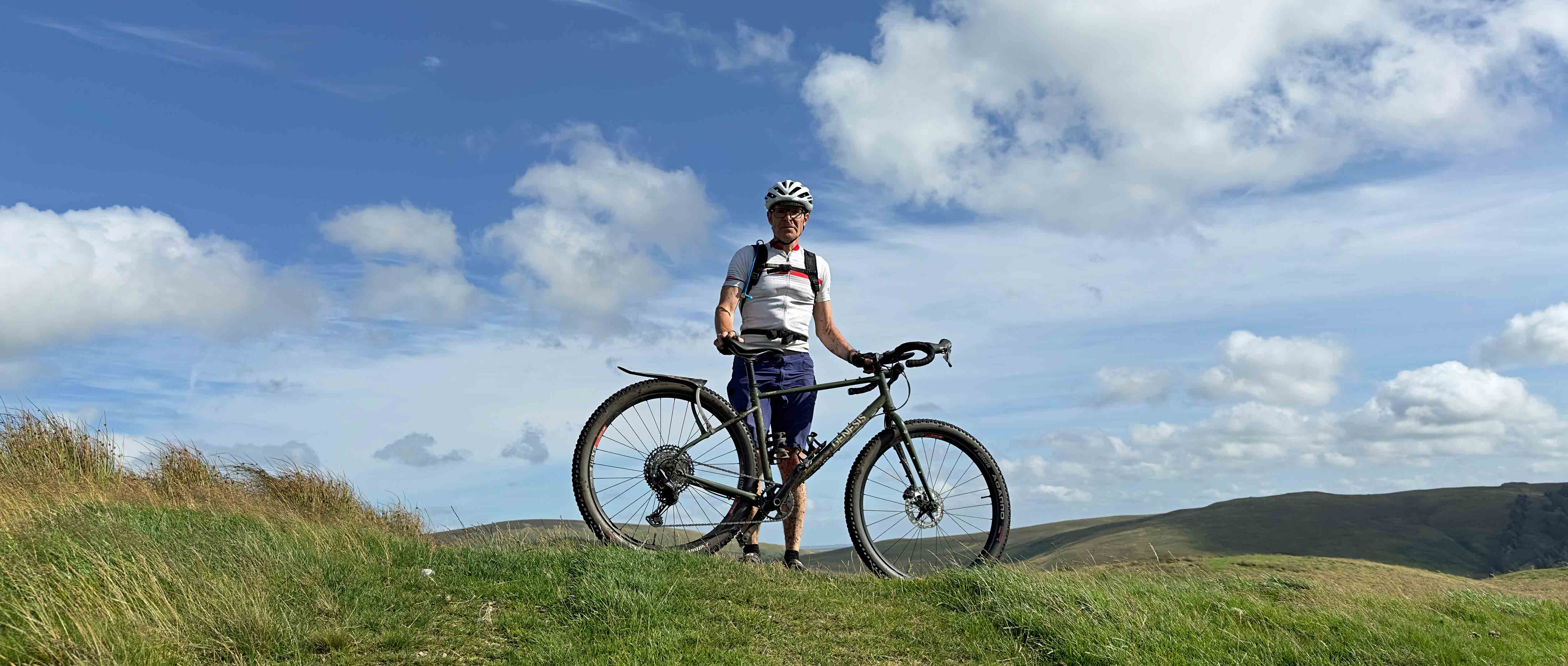
I persuaded my friend Graham to join me. He was monstercross ‘curious’ and didn’t need much persuading that the Vagabond would be the perfect bike for the ride. Riding someone else’s custom-built bike is always going to slightly different to riding a factory build, as everyone has their own personal preferences in terms of ‘perfect’ spec. If I’m honest, neither of us really got on with the super-wide flared bars, but the rest of the set-up was perfect. The 12 speed 10-51 cassette, paired with a 38-tooth front chainring offered exactly the right range of gears on a day where we climbed gradients of more than 20% in places, but also descended on screamingly-fast farm tracks. A dropper post on a gravel bike might seem like an unnecessary addition, but the fact it was plumbed-in to the left-hand shifter meant it was intuitive (and super speedy) to use and offered just enough drop to boost the confidence of the rider. I set the tyres at 1.4 bar/20 psi and they seemed to offer the goldilocks ratio of grip and comfort, while being surprisingly fast rolling – not something you would have assumed, based on the size of the tyre lugs. The Genesis brand manager, Brodie Gardias, was at pains to point out that officially the maximum tyre capacity of the frame was rated at 29x2.35”, but the 2.4” Agarros fitted in the frame with enough clearance on either side (to an untrained eye, anyway).
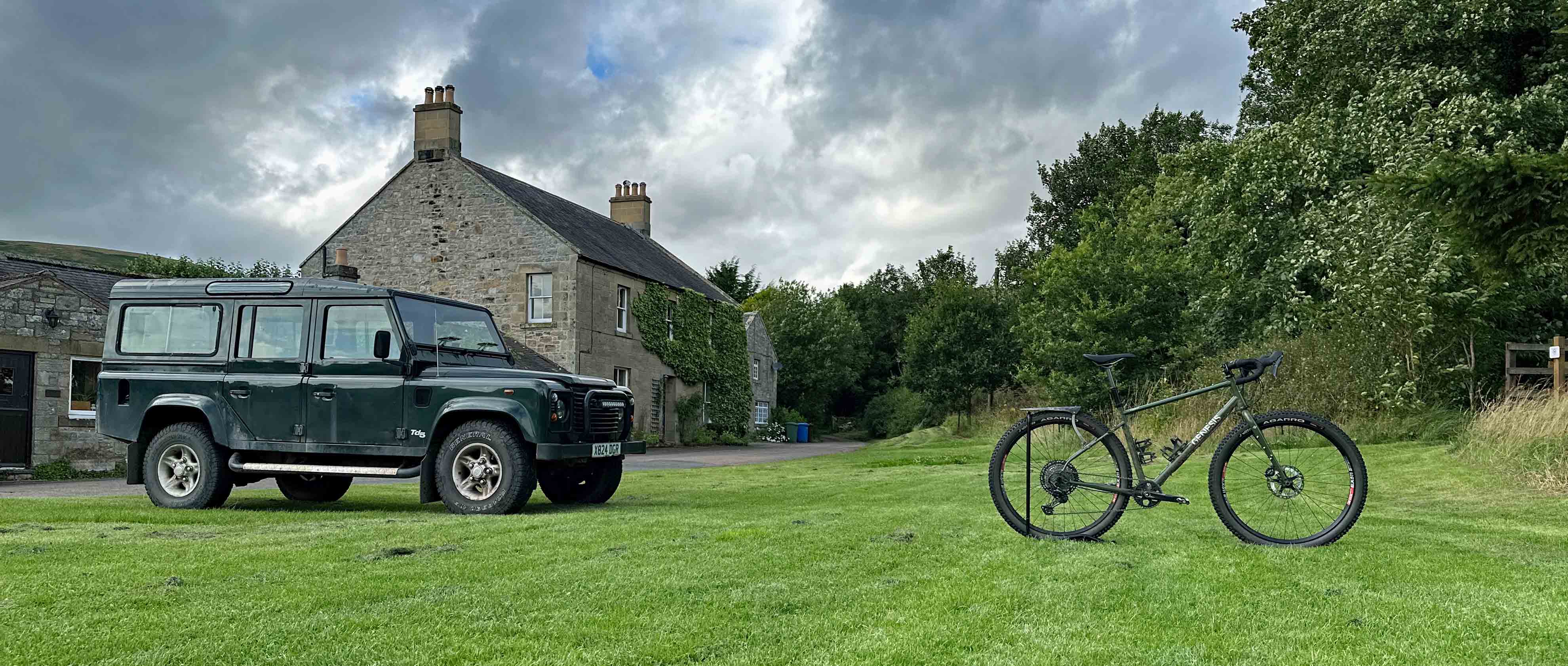
“It seems quite appropriate to put the Vagabond next to the Landrover,” said Graham “As they share a lot of the same ethos.” A ‘proper’ Landrover is still the vehicle of choice for many farmers and landowners in the north of Northumberland. The solid dependability, lack of fripperies, simple servicing requirements and rugged good looks could be equally said to apply to the Defender, as well as the Vagabond!
My proposed route included some sections of trail that I knew well, having previously ridden them with local rider and event organiser, Rich Rothwell, some bits taken from an iconic 1993 guide book to mountain biking in Northumberland and some on-line research. The section immediately before lunch said “here be dragons” on my mental map, but riding new trails across an unknown landscape is part of the fun and also one of major ‘drivers’ behind the Genesis Vagabond. I might have lulled Graham into a false sense of security with the initial section of trail – pan flat, hard packed gravel, which traversed the base of a beautiful U-shaped valley. As we swerved around the numerous potholes and dodged the occasional errant sheep, it gave our legs the chance the warm-up before our first challenge – the climb up towards Windy Gyle and the Scottish Border.
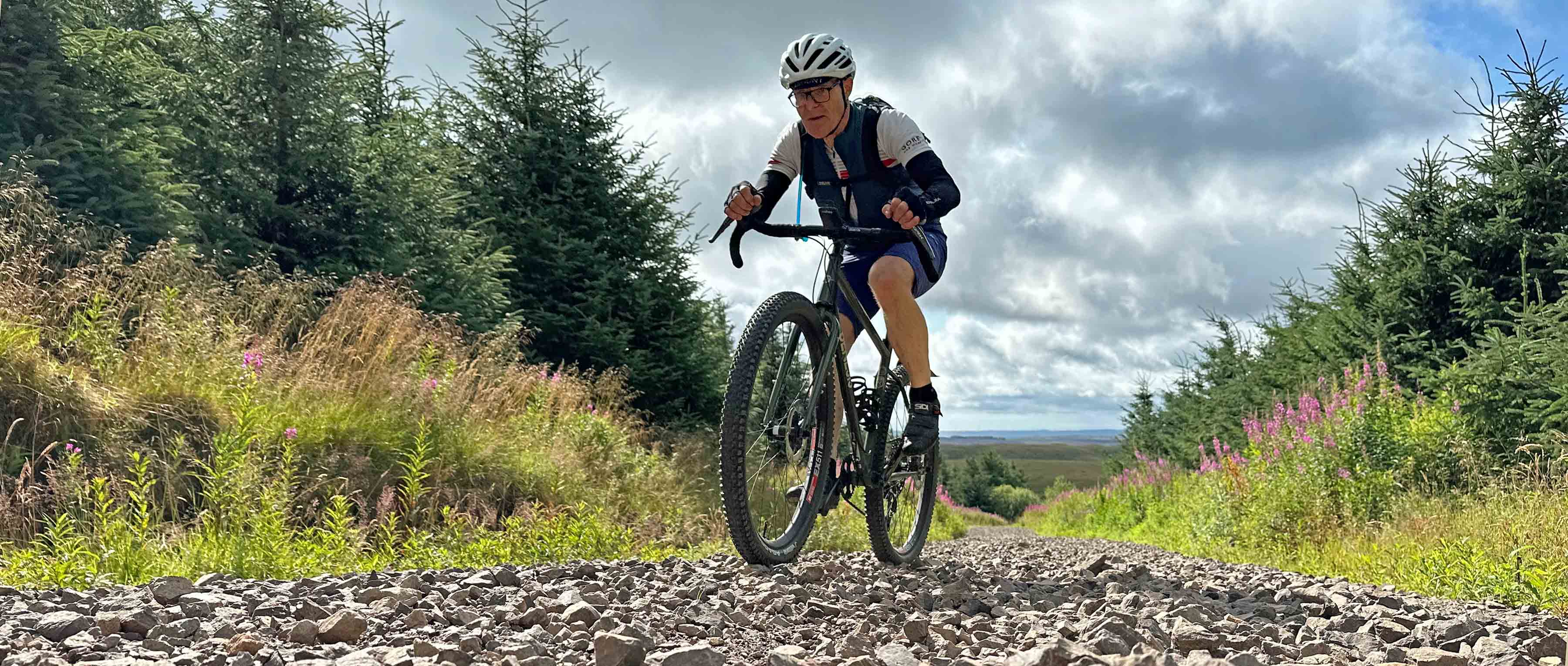
Sometimes, no matter how well you think you know a trail, things change. The first climb was a case in point. Back in March, I’d been here on a reccie ride with Rich Rothwell and although the surface of the first climb had been pretty variable in nature, it was at least reasonably compact. This time however it was very different – the surface of the track was completely covered in a thick layer of loose, crushed limestone aggregate. It was pretty hideous to ride up - our tyres scrabbled for grip, we skittered from one side of the track to the other in search of a smoother line and we used every sinew to try and balance the requirements of grip, power and speed. Fortunately, the 2.4” tyres on Graham’s Vagaond and the 2.25” tyres on my own monstercross gave us just enough cushioning and grip to make it safely up the 5 km long climb, although we burned quite a few matches on the way!
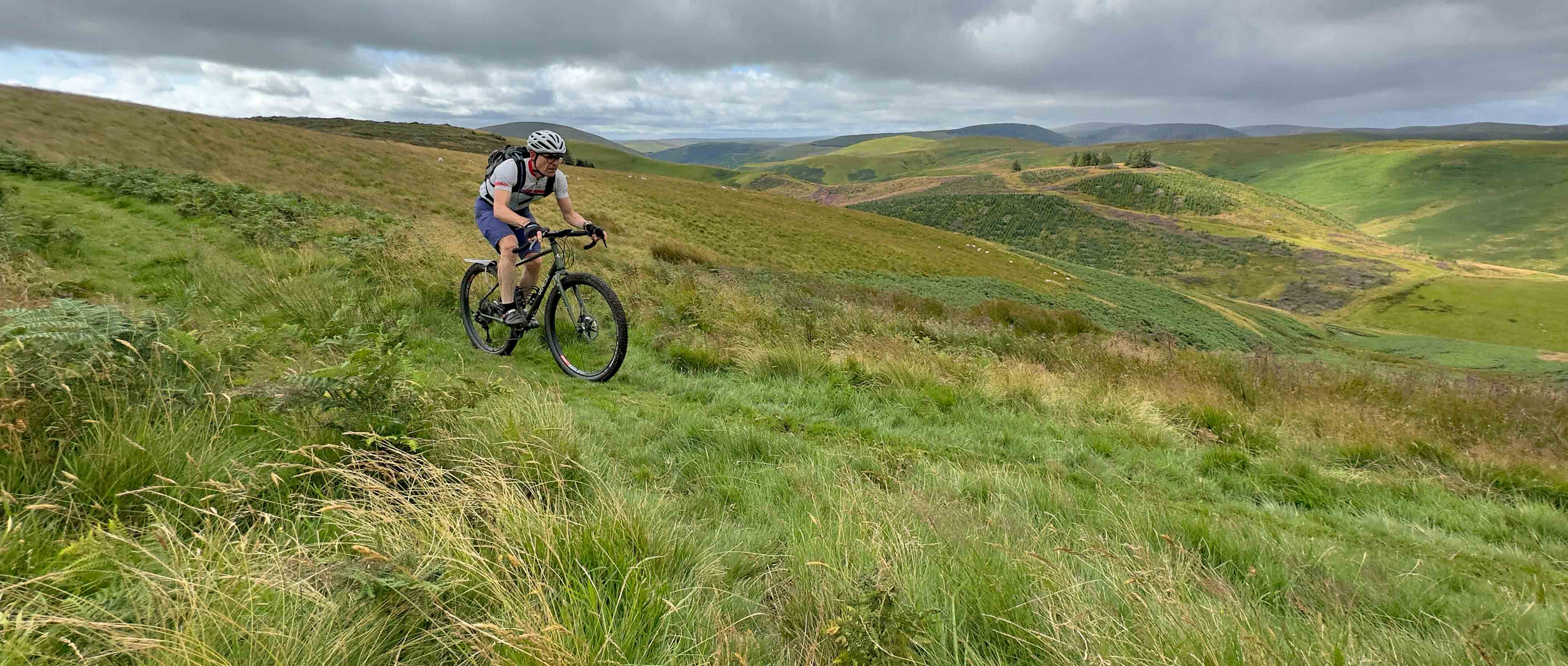
After the first of many super-fast descents, again covered in loose crushed limestone, we reached the end of the road. Or at least the end of the forest road anyway. From here our route took us on a fantastically fun, swoopy trail, initially traversing a hillside, before descending at high speed to the valley bottom. Although neither of us were huge fans of riding on the hoods with the Vagabond’s flared bars, on the fast descents that I’d included in the route, you could reach for the drops and here the flared shape made much more sense. With the seat lowered courtesy of the dropper post, you could let gravity do all the work. Graham flew down the first descent, putting a good gap between us by the time we reached the bottom.
From the low point, we climbed inexorably upwards to the English/Scottish border close to Windy Gyle. It was appropriately named on the day of our visit. An out-of-season storm brought high winds, with gusts up to 70 kph at times. Fortunately for us, we were wind-assisted on the big climb to the border. The winds gave us other benefits too – scudding clouds brought beautiful shadows and patches of light and they also helped dry out the trail. After a winter/spring/early summer of monsoon-like conditions in this part of the world, I was pleasantly surprised at how much drier the trails were than during my previous visit in March.
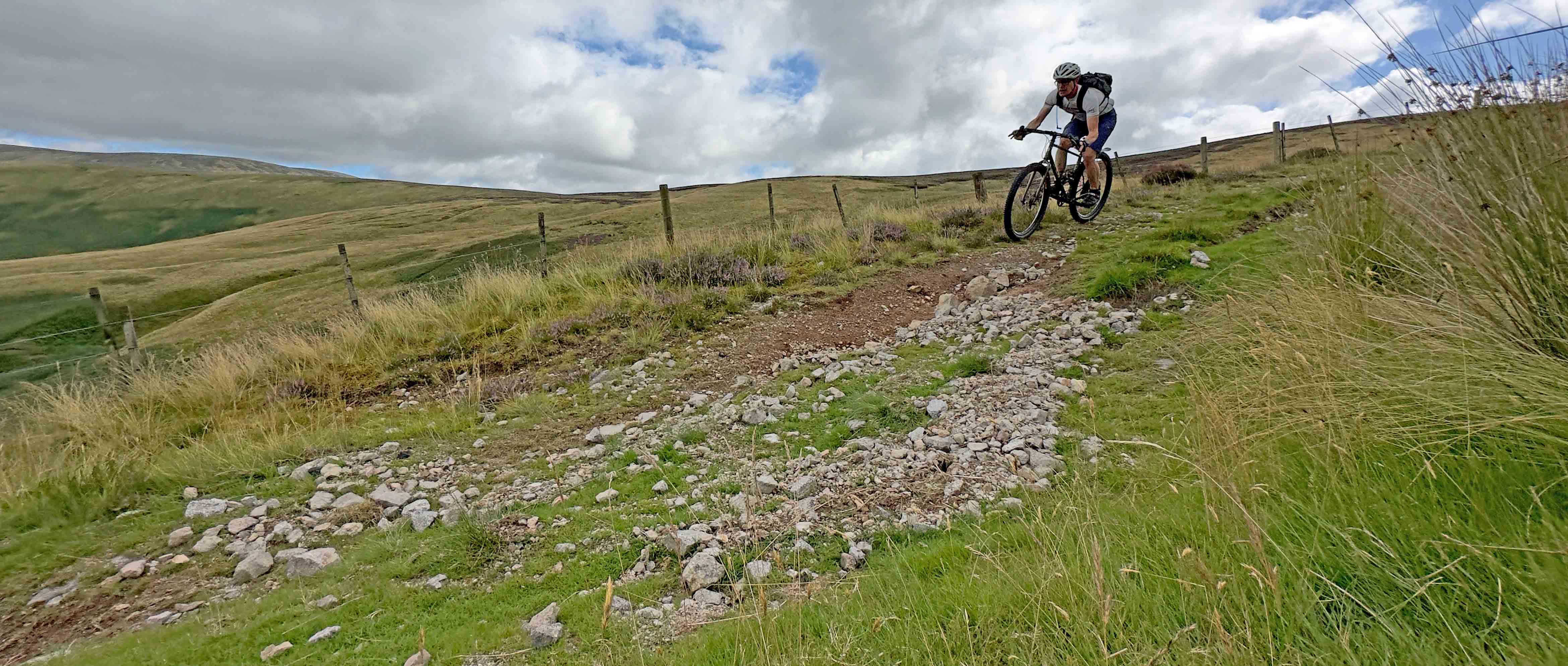
We made a brief stop at the imaginary passport control office at the border and then hurtled on down into Scotland. For anyone from outside the UK and unfamiliar with our archaic rights of way legislation, you might not fully appreciate our delight in having crossed the border. Thanks to significantly more enlightened Scottish legislation, there is a ‘right to roam’ offered to anyone using the outdoors (including gravel riders) in Scotland, so from now on, we wouldn’t be forced to stick to a drastically more limited number of legal route options available to us south of the border. I knew the descent pretty well and remembered that the initially smooth surface soon degraded into some seriously rocky sections, with one part where vast water runnels have been eroded into the surface. Again, the big tyres of our monstercross bikes came to the fore and we managed to avoid either the dreaded snakebite or shaking our fillings loose.
At the bottom of the descent, after a short section of riding on a tiny, paved road, our route veered sharply to the east, bound for the tiny collection of buildings at Sourhope. As we turned, our previously favourable tailwind morphed into a gusting sidewind as we wound our way ever higher up the slopes of The Schil. In typical fashion, just at the point where our hardpacked vehicle width trail petered out and our route became a narrow sheep track, the gradient also kicked up significantly and we both hopped off and started pushing – not something I would typically do on a gravel ride, but then this route wasn’t a typical gravel ride!
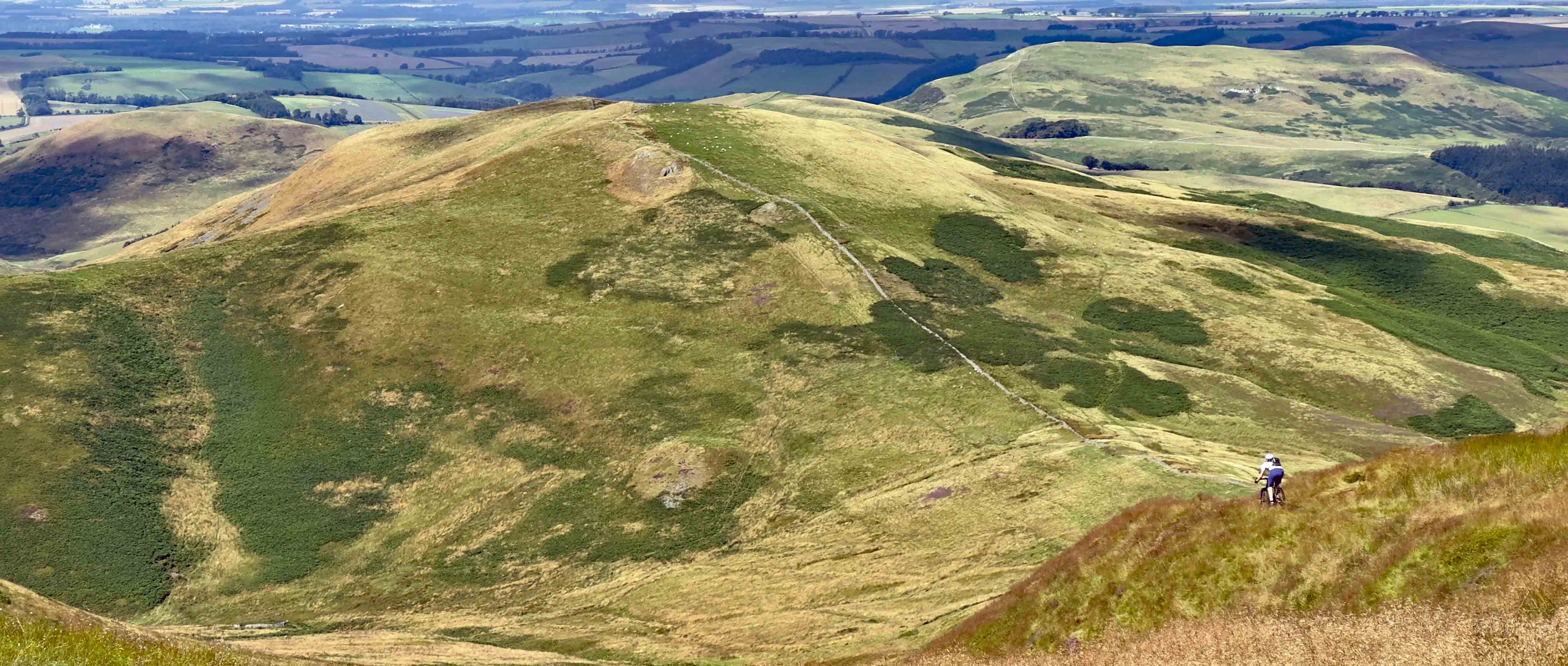
As we arrived at the grassy saddle located between the evocatively named Black Hagg and The Curr, we could make out the course of our descent heading roughly northwards. We had nearly 400m of height to lose between this point and our destiny with a pub dining room for a late lunch. To say it was one heck of a descent would be a blithe understatement. The trail looked like it had been bench-cut into the hillside and the surface comprised a dense sheep-nibbled grass sward – perfect for speeding gravel riders. The fact we had had great sightlines and the outstanding lack of other people in the area (we didn’t see another cyclist all day!) meant we could use the full potential of our monstercross machines and fly down the descent.
After the initial superfast section, the gradient lessened slightly before we rode over a small crest and discovered a perfect 180-degree hairpin bend laid out in front of us. With a stunning sun-dappled landscape in the distance, it was actually quite hard to try and concentrate on riding smoothly, as the distraction generated by the view was so strong. With only some slightly bemused-looking sheep for an audience, we hooned around the corner, huge grins on our faces and whoops of delight audible in the early afternoon air.
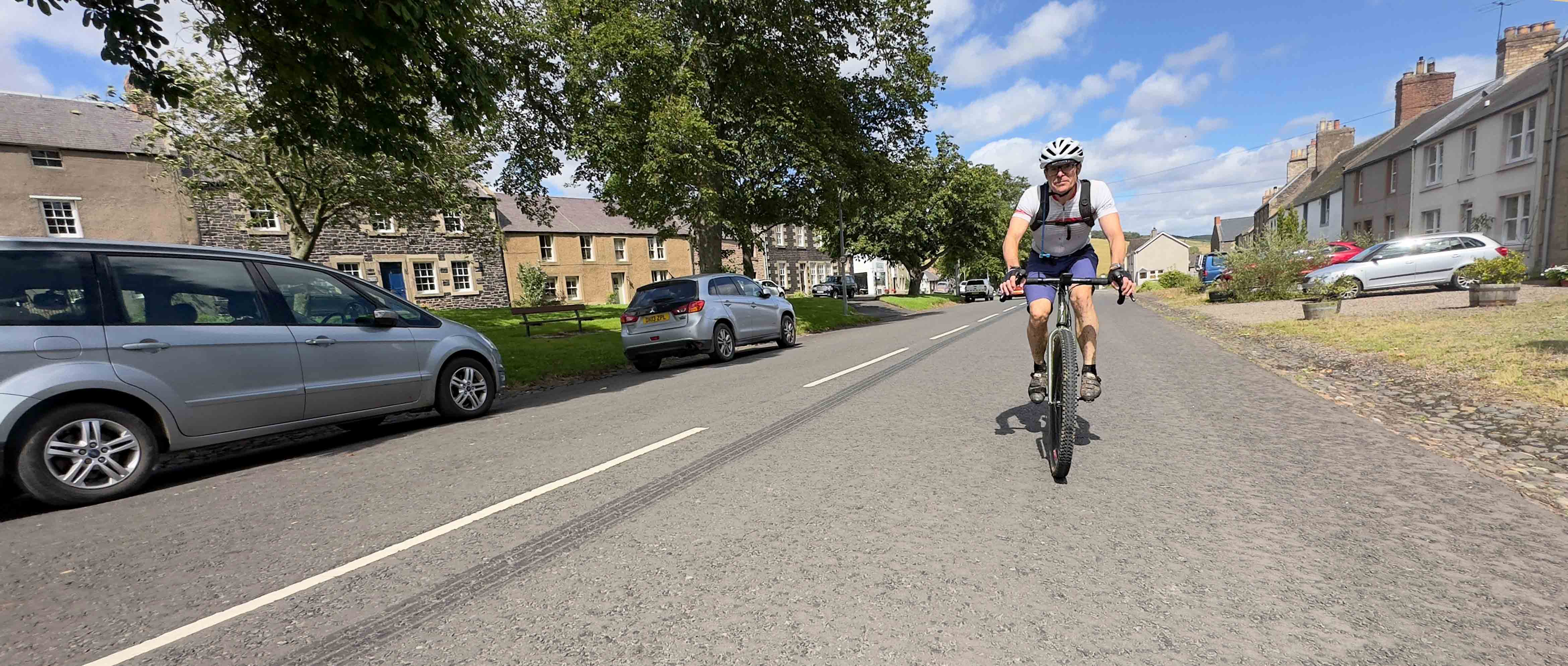
A fast descent down a gravel farm track, a swift swerve around a slightly overexcited bullock, a short steep tarmac climb and we arrived into the village of Kirk Yetholm, the start/finish point for the long-distance Pennine Way path. Rumbling stomachs and dropping energy levels spurred us on for a short section on tarmac into the adjacent village of Town Yetholm, where we took refuge from the wind and sought out cyclist-sized portions of lunch from the (highly recommended) Plough Hotel. Super friendly staff and regular customers didn’t bat an eyelid at the sight of two lycra-clad Englishmen crossing their threshold in search of food. “You know that we’re only just at the half-way point” said Graham, as he studied our route for the remainder of the day while ingesting homemade fruit crumble with custard.
As we waddled out of the Plough, bellies topped up with calories and water bottles full for the afternoon’s adventure, we were hit by an impressively strong blast of wind. Strong enough to knock over the seasonal fencing erected around the Plough’s beer garden, the wind would be straight in our faces for the section immediately after lunch – never ideal. After a quick stop to admire a front garden completely filled with a vast collection of gnomes, we hunkered down for a two-up time-trial along the B6401, before diverting off onto a tiny country road and fortunately into a more sheltered valley bottom.

Our route started to climb, gently at first, before gaining height more rapidly once the paved surface petered out and the gravel kicked in. This region of the borders was clearly popular with the pheasant and grouse shooting brigade. Once our tyres hit the gravel, every few minutes a trackside explosion of peanut-brained birds occurred and the birds tried to escape from the threat of marauding gravel cyclists (generally by flying straight into the wire mesh fences that surrounded their feeding areas). We were there just before the shooting season kicked off and it was quite a shock to see so many game birds being bred. It would be fair to say that I’m not a massive fan of the gamebird industry, especially from an environmental perspective, as the moorlands can become quite sterile if cultivated solely as a basis for shooting party’s enjoyment. The sole benefit from a gravel rider’s perspective, however, is that the desire for the shooting parties to be able to drive easily up into the hills is that the landowners have invested vast sums of money in having vehicle-width gravel tracks laid down. We followed one past Calroust Hopehead, steeply up to Belshaw’s Knowe and onto the Scottish/English border again. The gradient was so steep in places that we both resorted to hopping off and pushing.
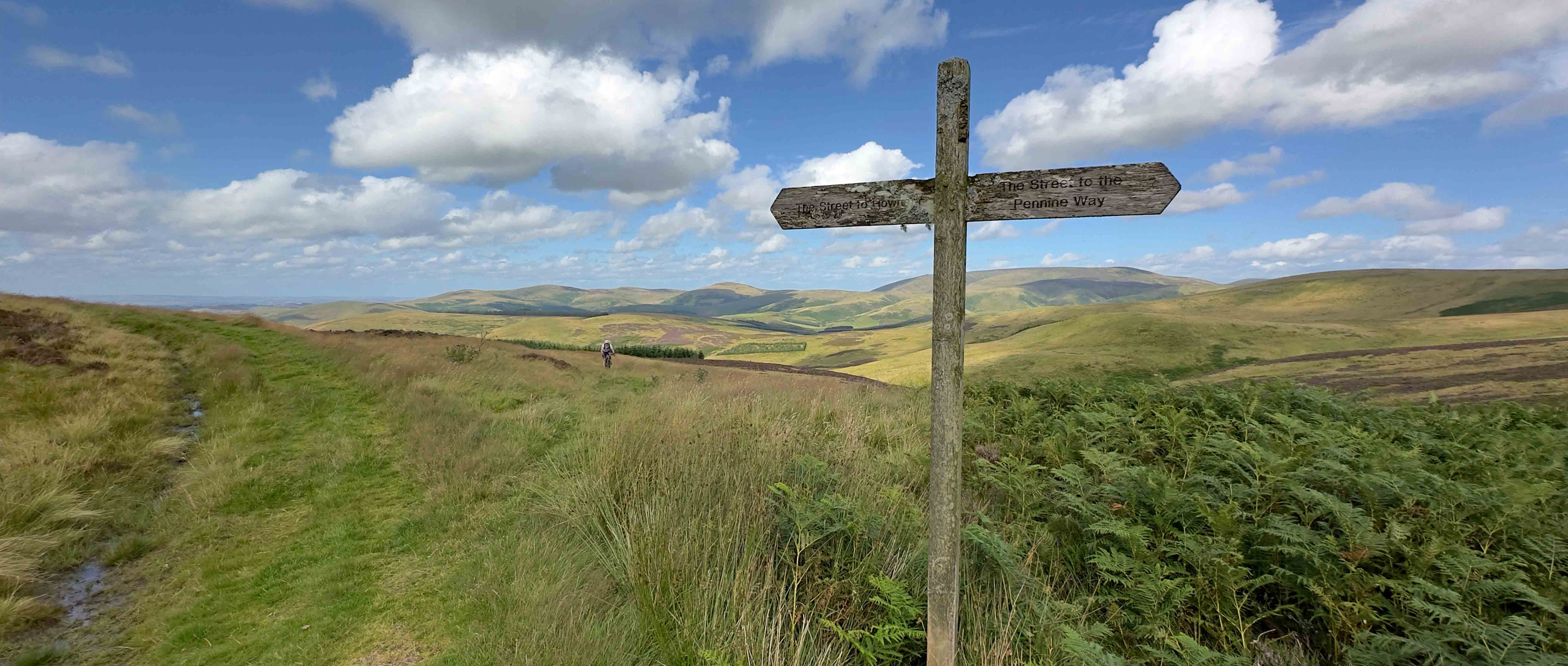
As the gradient eased off, we found ourselves on an incredibly ancient right of way known as The Street. Likely to have been used since medieval times as both a drove road and smuggler’s route across the border, the final section up to the border took us to 500m above sea level, the high point for the afternoon and the second highest point of the whole ride. As we crossed the border and started our descent back into England, we moved out of the wind shadow and were hit by the full force of a gusting crosswind. Typically, the upper section of the descent was along a grassy track, incised with deep ruts running parallel with our route. This required significant amounts of concentration to juggle the buffeting from the wind and the desire to not drop our wheels into the ruts. Fortunately, we survived intact and as we started the descent, our route changed course so that the wind arrived almost behind us.

The descent from the border was more than 6km long, enough to actually warrant stopping to look around at the view and marvel at how fast we could cover significant distances on our monstercross beasties. It was just as we were heading up a small rise, mid-way through the descent, that I stopped to look back to see my favourite view of the day. Graham was perfectly side-lit, with purply heather glowing in the background and the Scottish/English border visible in the far distance. A line of fence posts created the perfect visual trick to lead your eye into the view, so I whipped my phone out and fired off a few shots before the moment had passed. This shot seemed to sum up Northumberland gravel riding at its finest. Wild landscapes, no people anywhere in sight, fantastic trails and fortunately for us, stunning late summer weather.
The descent down The Street ends with a velvety-smooth grassy plummet back down to relative civilisation and the tiny, paved road which heads either over the Otterburn Ranges (if you turn north) or down the Coquet Valley if you turn south. We chose the latter option and had the joy of a super-fast descent on broken tarmac, strewn with gravel, but free from traffic. The road is only wide enough for one vehicle (or two gravel riders) and flows down the valley, with the River Coquet burbling beside you.
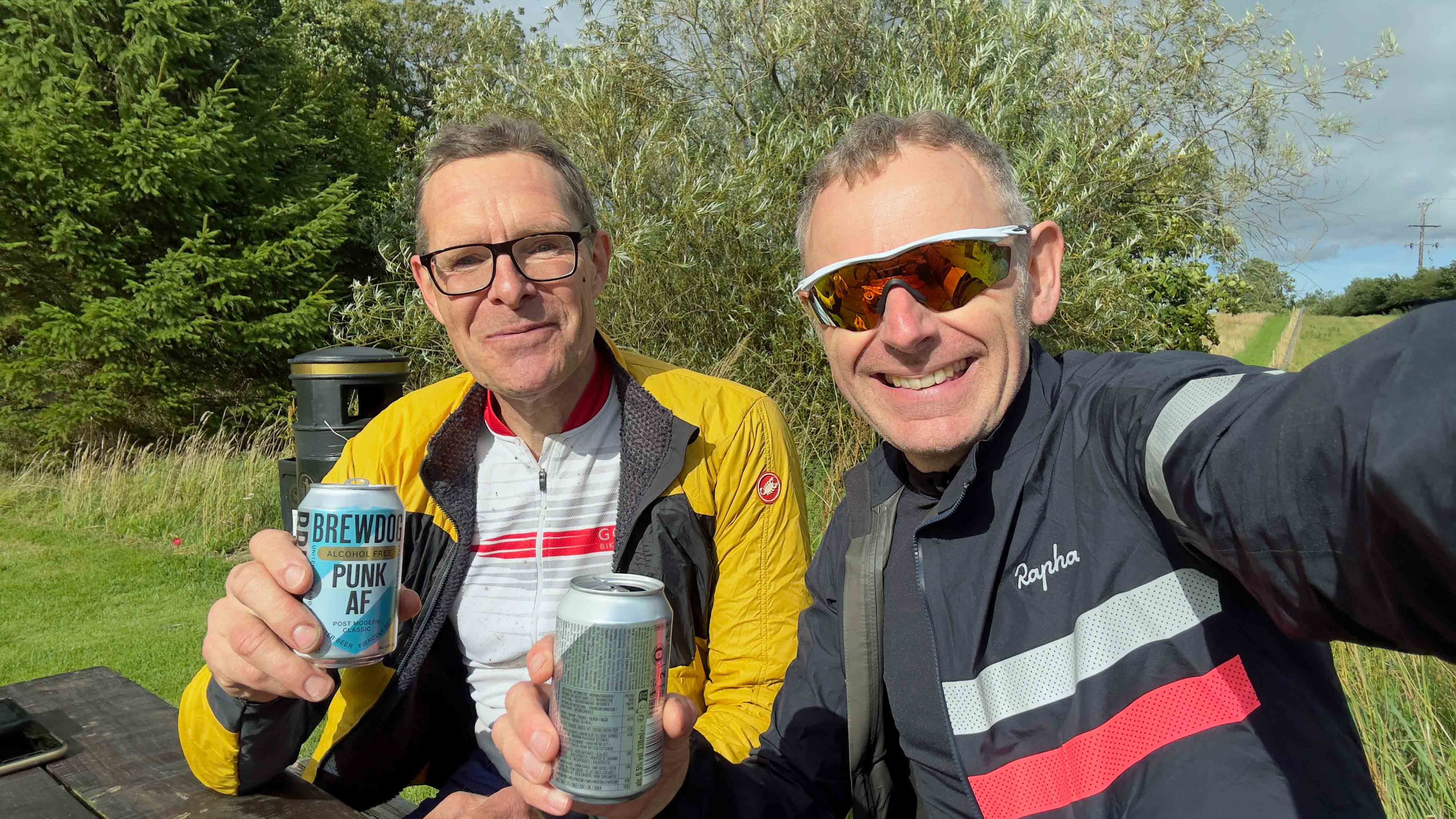
As we flew down the final stretch of road into the village of Alwinton where we had parked at the start of the ride, the sun burst through the late afternoon cloud and we were treated to 30 minutes of glorious late summer warmth – perfect for sitting on a bench and drinking a chilled post-ride beverage.
Graham neatly summed up the ride later in a WhatsApp message “It was an absolutely cracking day with the most amazing views. The big tyres on the Genesis were perfect for the terrain as it was too gnarly for a regular gravel bike and not hard enough for an MTB” I couldn’t have described it better myself!
If you would like to follow our tyre prints in the Cheviot Hills, you can find our route here:
If you would like to find out more about the Genesis Vagabond, head over to their website here.